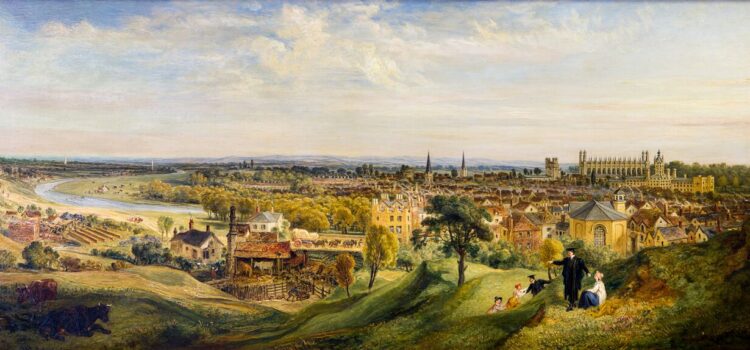Article by Dr N. Henry

At first glance James Ward’s painting, kept at the Museum of Cambridge, appears like a typical 19th century pastoral scene reflecting the contemporary nostalgia for a simpler lifestyle and beautiful green spaces. The scene depicting a farmer at work (on the left hand-side) is typical of the time. More interesting is the right hand-side of the picture representing two young men in academic dresses helping a group of three young women climb up Castle Hill to admire the view.
Caroline Bigg’s new book “The Spinning House” and its depiction of misogyny and violence against young women in Cambridge at that time contrasts heavily with this idealised depiction of young people hanging together on Castle Hill. In reality young male students were discouraged from socialising with girls from the town and the latter were imprisoned by the University if even found walking in the streets of Cambridge by the proctors and their bulldogs. This is what happened to Elizabeth Howe (19 years old) who was arrested in November 1846 under ancient laws that granted the University the right to incarcerate young women.

Such laws, that encouraged misogyny and violence against women, contrast with the image of gallantry and courteous love depicted in James Ward’s painting. Most interestingly the painting seem to have been commissioned by the Percy family (of the Duchy of Northumberland) in 1840, possibly when Hugh Percy became chancellor of the University of Cambridge ( 1840-1847) having previously been a student at Saint John’s College. As head of the University he would have been ultimately responsible for the violence against young women perpetuated by the institution.

The painter, James Ward, is unlikely to have been aware of the ancient laws used against young women when he was working on his painting. Early pencil sketches, currently held by Yale University and probably done in situ, just show a preparatory outline of the view. The group of young men and women was probably added later when the painter came back to his studio in London. He clearly wanted to paint the town as a place of scholarship (the gowns) youth and romantic love, an image that did not quite reflect the true attitude of the University towards the young women of the town who were unjustly persecuted and victims of the most monstrous misogyny and corporate violence.
